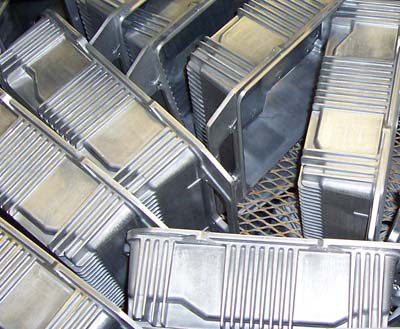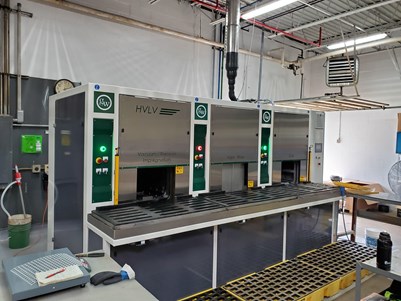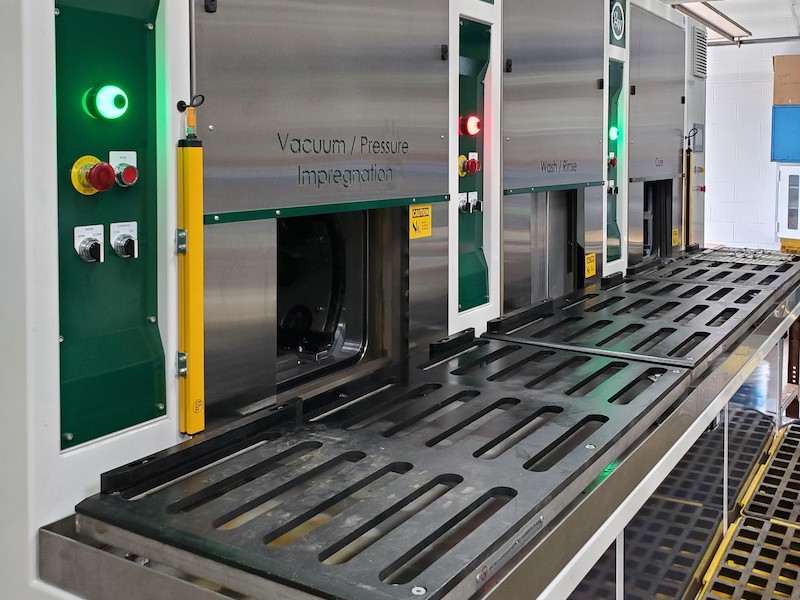For metal castings and powder metal parts exposed to harsh, high-pressure, or vacuum environments, holes and fissures are unavoidable.
These defects can allow corrosive elements to enter your parts and eventually lead to equipment failure. This is a common and pervasive problem particularly with castings made of zinc, aluminum, bronze, and other metal alloys. These aberrations can be particularly worrisome with machinery that circulates fuel, oil, or hydraulic fluid. Leaks within these parts can not be only costly, but dangerous.
However, rest assured that these apertures are not a death knell for your equipment. With vacuum pressure impregnation, you can:
- Avoid damage from harsh environmental conditions
- Prevent leaks
- Ensure that moisture or other corrosive elements will not enter and cause internal damage to your parts
- Ensure that sealed parts that will retain pressure requirements
How does Vacuum Impregnation work?
 First, let’s talk a little bit about why defects occur during the metal casting process to begin with. Porosity can be caused by gas formation or solidification shrinkage. Gas-related porosity stems from gas bubbles that get trapped inside the molded form as the metal solidifies. Fissures caused by solidification shrinkage, on the other hand, are a result of sections of casting that harden later than the other parts.
First, let’s talk a little bit about why defects occur during the metal casting process to begin with. Porosity can be caused by gas formation or solidification shrinkage. Gas-related porosity stems from gas bubbles that get trapped inside the molded form as the metal solidifies. Fissures caused by solidification shrinkage, on the other hand, are a result of sections of casting that harden later than the other parts.
Vacuum impregnation works through sealing porosity and leak paths that may form during the metal casting process. This process works without adversely affecting the dimensional integrity, physical appearance, electrical property, surface resistance, or any other functional characteristics of the parts.
While there are various types of sealants used, most use thermosetting epoxy resins which are formulated to swell slightly upon curing, thus locking into the defect. These sealed epoxy resins offer excellent chemical and moisture resistance and are thermally stable from -40 to 400F. At Anoplate, vacuum impregnation is governed by military specification MIL-STD-276A as well as proprietary corporate standards. The sealant used is covered by MIL-I-17563C.
- Parts typically require vacuum impregnation include:
- Valves containing liquid or gas
- Electronic housings
- Hydraulic manifolds under pressure
- Vacuum pumps
- Compressor parts
- Optical components that operate in a vacuum
- Fluid cooled component
There are three primary types of vacuum impregnation:
- Dry Vacuum and Pressure (DVP). This is the strongest form of impregnation most commonly used for automotive, aerospace, and defense equipment. It is designed to treat critical leaks in very high-pressure environments.
- Dry Vacuum (DV). This process is similar to DVP, but without the final pressure stage. While it is effective in sealing porosity and leak paths, it takes longer and it is less thorough than DVP.
- Wet Vacuum (WV). This process uses anaerobic sealants and is used primarily for sealing powdered metal parts and electrical components. It is typically the low-cost option and is generally considered less effective than DVP or DV.
Vacuum Impregnation Processes at Anoplate
 Anoplate uses Godfrey & Wing’s innovative High-Value Low Volume (HVLV) continuous flow impregnation technology to replace a more traditional batch flow approach. This HVLV technology contains a Dry Vacuum and Pressure (DVP) impregnation chamber.
Anoplate uses Godfrey & Wing’s innovative High-Value Low Volume (HVLV) continuous flow impregnation technology to replace a more traditional batch flow approach. This HVLV technology contains a Dry Vacuum and Pressure (DVP) impregnation chamber.
The dry vacuum guarantees that air is removed from the leak path or porosity allowing the sealant to go deep into the casting. As previously implied, it is also the most thorough form of impregnation that provides the highest possible yield of leak-free compounds. Single-piece flow equipment enables Anoplate to conserve resources (floor space, sealant, and electricity) while achieving nearly 100% sealing performance. This efficiency is particularly important as many of our clients are in the aerospace and defense industries.
Through our process, we are able to provide our customers the security of knowing their pressure retention requirements will be met throughout the life of the component.
Visit https://www.anoplate.com/
Nick Treby is Regional Sales Manager and Marketing Specialist at Anoplate



































